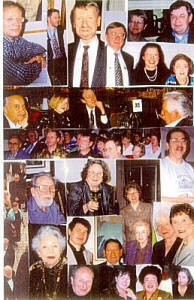| |
|
Wagner
Society of Dallas
Invites you to a
MATINEE CONCERT
"Richard Wagner and the Ritter Viola"

"Ritterbratsche"
Saturday, March 26, 2005, 2:30 pm
4808 Drexel Drive - Dorothea Kelley "Concert Hall"
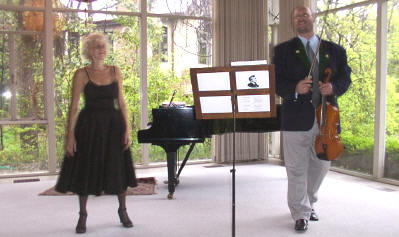
PROGRAM:
Carl Smith - Ritter Viola & Bella Gutshtein
- Piano
Carl Smith was born in Binghamton, NY,
where he
began violin studies at the age of 5. As a student, he took part
in international chamber music tours. In 1976, he studied with
Nadia Boulanger at Fontainbleau, France, and thereafter with
Scott Nickrenz in Boston. Since 1978, he has been a member of the Graz
Philharmonic Orchestra, and the Natal Philharmonic Orchestra
in Durban, South Africa. In 2001, he transferred to the Ritter
Viola, and has been touring
as a soloist on the "Ritter Viola".
Bella Gutshtein was born in St.
Petersburg, Russia. Her piano studies were at the St. Petersburg
Conservatory. She is a faculty member of the AIMS Summer Music
program in Graz, Austria. She is founder of the Russian Cultural
Society in Naples, Florida, where she lives.
You may contact Carl Smith directly at the address below.
Carl Smith
Bergmanngasse 15
A-8010 Graz
Austria-Europe
Tel:Fax: +43-316-817683
csmith@netway.at
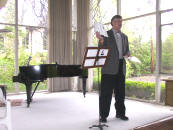
WSD President
Roger Carroll Makes Announcements |
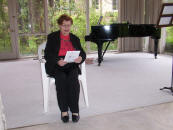
Virginia Abdo Presents Program Notes about
the Ritter Viola |
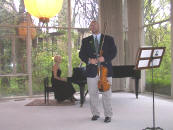
Carl Smith and the Ritter Viola, with Bella Gutshtein at
the Piano |
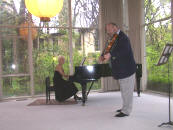
Tuning |
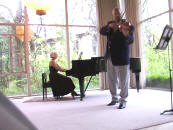
Playing |
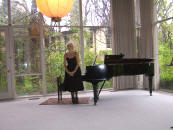
Bella Takes a Solo Bow |
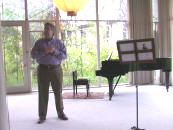
WSD Treasurer
Greg McConeghy |
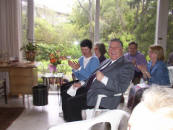
Ron Hudson
Concert Sponsor |
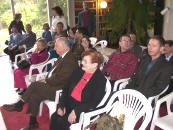
A Good-Sized Audience Assembles after Intermission |
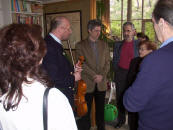
Greeting Audience |
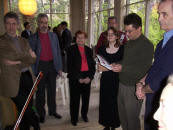
Interested Questioners |
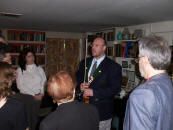
Carl Smith Explains |
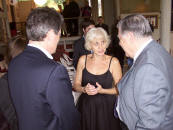
Bella Gutshtein |
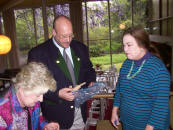
An Interesting Gift |
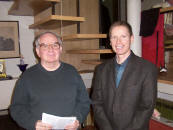
David Morgan
and Kyle Kerr |
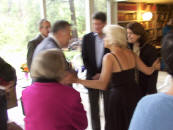 |
 |
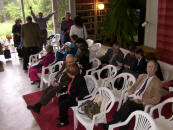 |
| Light
Refreshments after the music |
Photos for WSD by Ed Flaspoehler - Click on
Images for Enlarged View
Richard Wagner
and the Ritter Viola
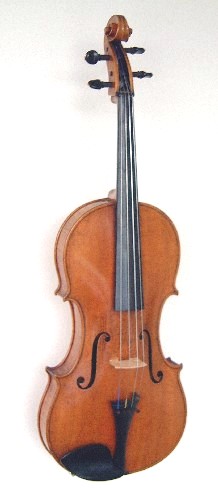 The term, "Ritter viola", refers to the violist and music
author Hermann Ritter. Ritter was born on September 16, 1849 in
Wismar, Germany, and died on January 25, 1926. In 1865, Ritter
began violin studies at the "Neuen Akademie der Tonkunst" (New
Academy of Tonal Art) in Berlin. He studied there until 1870,
giving lessons to finance his education. He studied there for a
short time with Joseph Joachim. In 1870, he became a member of
the Court Ensemble in Schwerin for two years, followed by the
position as conductor of the Heidelberg City Orchestra. He
retired shortly from this position to study music and art
history and philosophy in Heidelberg University. During these
studies, he turned to the viola, with the aim to equal its tone
to that of the violin and cello. In his study of the development
of stringed instruments, he stumbled across the manuscript
"Geometric Principles of Violin Making" by Antonio Bagatella,
printed 1782 in Padua, Italy. According to these principles, he
commissioned the Wurtzburg violinmaker, Karl Adam Hoerlein
(1824-1902), to build him a "Viola alta", as he termed it. Most
likely from a recommendation of Professor Ludwig Nohi, with whom
Ritter had studied music history, he was invited to Bayreuth. The term, "Ritter viola", refers to the violist and music
author Hermann Ritter. Ritter was born on September 16, 1849 in
Wismar, Germany, and died on January 25, 1926. In 1865, Ritter
began violin studies at the "Neuen Akademie der Tonkunst" (New
Academy of Tonal Art) in Berlin. He studied there until 1870,
giving lessons to finance his education. He studied there for a
short time with Joseph Joachim. In 1870, he became a member of
the Court Ensemble in Schwerin for two years, followed by the
position as conductor of the Heidelberg City Orchestra. He
retired shortly from this position to study music and art
history and philosophy in Heidelberg University. During these
studies, he turned to the viola, with the aim to equal its tone
to that of the violin and cello. In his study of the development
of stringed instruments, he stumbled across the manuscript
"Geometric Principles of Violin Making" by Antonio Bagatella,
printed 1782 in Padua, Italy. According to these principles, he
commissioned the Wurtzburg violinmaker, Karl Adam Hoerlein
(1824-1902), to build him a "Viola alta", as he termed it. Most
likely from a recommendation of Professor Ludwig Nohi, with whom
Ritter had studied music history, he was invited to Bayreuth.
Ritter meets Richard Wagner
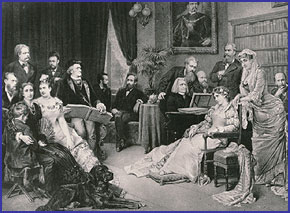
Wagner receives Liszt in the Villa Wahnfried
Hermann Ritter present
Richard Wagner was constantly in search of new tonal colors,
especially in the mid-register. Therefore, the viola developed
by Hermann Ritter was highly welcomed by him.
Wagner's special interest in strong mid-register instruments
is well known. In 1875, he prescribed in his works in place of
the English born an "Alt-Hoboe", which was constructed by the
instrument maker Stengel, according to Wagner's instructions.
This instrument had a larger bore size than the English horn.
Its sound bell had the shape of a pear, in contrast to the
normal English horn. Cosima Wagner remarked in her diary,
February 9, 1876: "Mr. Ritter, from Heidelberg, is bringing a
new type of viola, which Richard finds excellent and wishes to
introduce into his orchestra".
Ritter described his meeting with Wagner in his work,
"Richard Wagner and the Inventor of the Viola alta", with the
following dialogue: "The guests arrived and he announced that I
would present and perform on a better tone-developed viola. I
should play 'something, which you can demonstrate all the
strings'. He said further, 'Fischer will accompany you on the
piano'.
"I chose Wolfram's Fantasy from Tannhauser and was
accompanied by the now famous Court Conductor, Franz Fischer. As
I finished, the Maestro tapped me on the shoulder and said:
‘Your instrument sings wonderfully! It's a shame I wasn't
familiar earlier with it. What all I could have written in the
orchestra for it! Incidentally, you are not a candidate for
philosophy, but rather a true musician. Remain with your art and
let the doctor title go! What need does a musician have for a
doctorate?'
"Pointing to my Viola alta, Wagner stated, 'The correct alto
voice! I know several beautiful pieces for your instrument from
the sonatas for violin and harpsichord by Bach which lay heavily
in the mid-register. Could six such Altviolins of your
construction be included in the Festival Orchestra?' I answered,
'Surely, Maestro, if persons can be found, thatwould play them.'
- 'I will speak with Thoms in Munich.'
"Later, as Wagner spoke in my presence with this violist from
the Munich Court Theatre Orchestra, he asked, 'Why can't we have
more Ritter Altviolins?' Answered Thoms, ' Yes, Maestro, it's
difficult. It could be done but we'd have to learn!' "
Later, Wagner wrote Ritter a tong letter with the following
script and engaged him as solo violist for the Bayreuth Festival
Orchestra:
Respected Sir! I am truly sorry still not to have sufficient
time to deal with your Altviolin at the length I feel noteworthy
and to lend my support in giving this instrument it's earned
respect. I am convinced that the general introduction of the
Altviolin in our orchestras is not only the intentions of
composers, who, up to now, intending the voice of the true
Altviolin sound but having to make do with the normal voila,
which can now be put into rightful perspective and which will
also bring about a meaningful and advantageous change of the
whole treatment of the stringed instrument quartet, The free
A-string of this no-longer thin and nasal sounding, but rather
bright and good-sounding instrument, will replace the reserved
middle four string of the violin with an energetic voice, as the
violin has been limited so much in its energetic projection of
sound in this register, that Weber here, for example, very often
had to add a wind instrument (clarinet or oboe) for support. The
Altviolin makes this no longer necessary and the composer
doesn't have to make use of mixed colors where the pure string
character was the intention. Now it is hoped for, that this
greatly improved instrument be immediately distributed among the
best orchestras and the best violists be quickly urged to give
it serious treatment. We must be prepared here for great
resistance, as unfortunately the majority of most of the
orchestra violists are not at the height of string
instrumentalists.
A hearty initiative will attract followers, whose example
will quicken conductors and administrators. I regret you have
brought this affair to me so late and that,, especially at this
time, being so busy, I have not been able to do as much as
possible in this short time, I request to be informed regarding
the attention of your instrument by the respected court musician
Thoms in Munich. My friend, Fleischhauer (concertmaster in
Meiningen), has already stated his willingness to recommend the
Altviolin for the upcoming festival in Bayreuth. Having the
possibility to have at least two of these instruments played in
my orchestra, I regret not being able to already have six of
them. It appears to be impossible.
I request exact information about what success has been
attained and that you make unrestricted use of me and my
recommendation in your cause.
I thank you for your most interesting and informative
treatise and remain respectfully at your service
Richard Wagner.
Bayreuth, March 28,1876
Wagner did, in fact, eventually have six Ritter violas in his
orchestra.
Berlioz was also not pleased with the sound
of the viola in his day, which is documented by his following
statement:
Here it must be said that most of the violas at present in
our French orchestras have not the necessary dimensions. They
have neither the size, nor as a natural consequence the tone
power, of a real viola; they are mostly violins strung with
viola strings. These Musical Directors should absolutely forbid
the use of these bastard instruments, whose tone deprives one of
the most interesting parts in an orchestra of its proper color,
robbing it of all its power, especially in the lower registers.
In the following years, Hermann Ritter had great concert
success, and the Ritter viola, as it was commonly referred to,
began to break through.
When the violinmaker, Hoerleln, died, Philip Keller acquired
the moulds in 1902. He was authorized by Prof. Ritter to build
this viola and also developed the 5-string Ritter viola. The
Ritter viola in the instrument collection of the Munich City
Museum bears the label:
"Viola alta (Altgeige)
nach Modell Prof Hermann Ritter
Autorisierter Verfertiger: Phil. Keller Atelier fdr Geigenbau
und Bogen
1906 Wurtzburg, gegr. 1832 Nr. 95 ".

"Ritterbratsche"
Following Ritter's Death,
The Instrument was
Forgotten
Following the death of Hermann Ritter in 1926 it became quiet
regarding the Ritter viola. In 1929, when the viola society put
out the question, asking "Who still plays the Ritter viola?",
only one former student of Ritter, the concertmaster from
Elberfeld, Karl Paasch, replied, "I am a former student of
Professor Ritter and I gladly play the Ritter viola as a solo
instrument. I also play it in the orchestra when its character
deems proper, specifically for particular solos with great tone,
such as: Harold symphony - Kaminski Magnificat - Tristan solos
in Bayreuth - H. Wolf. Italian Serenade, etc. Occasionally, I
arrange to have a normal and a Ritter viola in the orchestra and
switch between them both."
The Royal Saxon Chamber Virtuoso, Alfred Spitzner, replied
similarly in his authored title, "The Viola in Word and
Picture": "Ritter rightfully states that it is completely false
to produce a nasal tone from the viola in normal fashion. He
attempted to help this situation with his improvement of the
Viola alta. There are, in fact, a few good old violas that are
not nasal. Unfortunately, the dimensions of the Ritter viola are
so disadvantageous, that they are very strenuous for a player
that does not have long arms and fingers, especially in the case
of our present-day composers. To ease these dimensions, Ritter
newly added an additional 5th E string."
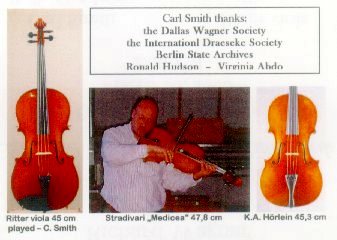
In fact, the size of the Ritter viola does not make it easy
to play. While normal violas have a body length of 37-42 cm,
measured across the top plate, the above-mentioned Ritter viola
in the museum has one of 45.3 cm with a complete length of 73.9
cm. The vibrating string length is 40.6 cm.
The 5-string Viola alta, which
also was built by Philipp Keller in Wurtzburg, was more
advantageous to violists. A 5-string Ritter viola in the City
Museum has a 2.7 cm shorter length of 71.2 cm, with a body
length of 43 cm. The vibrating string length of this instrument
is also 40.6 cm.
Herrmann Ritter imagined this
5-string viola for his idea of a string quartet, comprised of a
normal violin, the 5-string viola, a tenor violin an octave
lower than the violin and a cello. The composer, Felix
Weingartner, authored in 1905 a well-wishing article in the
magazine, "Die Musik". He made specific mention of the tone
characteristics of the mid-register instruments developed by
Ritter: "In the tonal function I noticed the penetrating
character
of the 2nd violin voice, due to that it was played on a viola
seated across from the violin, while the tenor violin's voice
was more pronounced to that of the cello and higher voices. More
tonal independency of the 'middle registers was, therefore, the
opinion of my observation. This is explained in that, while the
normal quartet being represented by three individualities, the
violin, viola and cello, we have here four completely separate
ones, in the true meaning of a quartet. A great tone production
goes hand in hand with a much darker tone color, having a
wonderful effect in certain passages, which is nevertheless
certainly not the overall intention of the composers."
Richard Strauss (I 864-1949) also
made mention of the 5-string Ritter viola in a footnote of his
1904 expanded and revised instrumentation treatise by Hector
Berlioz:
Prof Hermann Ritter from Wurtzburg built a 'Viola alta" which
has an additional higher-tuned 5th string in addition to the
normal four. The instrument portrays a much more pronounced tone
volume, due to its size and has, on the other hand, a very
usable higher pitch, due to the added fifth.
Its use today is unfortunately still very limited, which is
due to the fact, that the manual facilitation of the Ritter
viola requires a lot of physical strength; Players with short
arms and fingers should consider exchanging it for the more
comfortable normal viola.
Richard Strauss was practical enough to foresee the playing
difficulties of this large instrument. Ulrich von Wrochem from
Milano impressively demonstrated the characteristics of this
viola in a concert in the Munich City Museum.
It is suspected and remains to be explained whether the
viola/violin part of the solo violist in Strauss' opera,
"Elektra", was, in fact, actually intended for this 5-string
Ritter viola. - C. Smith
Dr. Gunther Joppig
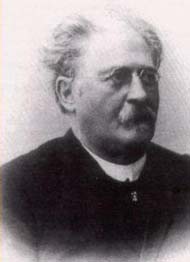 Johannes
Brahms (1833-1897) viewed Felix Draeseke (1835-1913), along
with Anton Bruckner (1824-1896), as his main rival in the
symphonic and religious field of composition. At first this may
surprise us, but this reaction ends quickly when one listens to
the third symphony, bearing the title, "Symphonia tragica". Draeseke certainly did not have to hide behind his famous
contemporaries, even though he never received wide pubic
acclaim. In the field of experts this was not so. It was not
only Brahms who respected Draeseke. Personalities such as Hans von
Bulow, Arthur Nikisch, Fritz Reiner, Hans Pfitzner or Karl Boehm
also quickly recognized Draeseke's compositional qualities.
Nevertheless, this recognition did not gain wide-spread
acceptance of his music. Johannes
Brahms (1833-1897) viewed Felix Draeseke (1835-1913), along
with Anton Bruckner (1824-1896), as his main rival in the
symphonic and religious field of composition. At first this may
surprise us, but this reaction ends quickly when one listens to
the third symphony, bearing the title, "Symphonia tragica". Draeseke certainly did not have to hide behind his famous
contemporaries, even though he never received wide pubic
acclaim. In the field of experts this was not so. It was not
only Brahms who respected Draeseke. Personalities such as Hans von
Bulow, Arthur Nikisch, Fritz Reiner, Hans Pfitzner or Karl Boehm
also quickly recognized Draeseke's compositional qualities.
Nevertheless, this recognition did not gain wide-spread
acceptance of his music.
Revolutionary new ideas in the
beginning of the 20" century left Draeseke quickly behind and
forgotten. When one opens a common program guide, usually no
more than a couple lines of information about Felix Draeseke can
be found. For example: "Felix Draeseke (1835-1913), in light of
Schumann, Brahms and Liszt, stands at the gate of late
romanticism. Occasionally one hears his attractive Serenade D
major, op.49 (1988) or (from 4 Symphonies) the
Tragica, c minor,
op.40 (1886). His brilliant piano concerto (1886) and the violin
concerto (1881) are forgotten." (Reclams Konzertfuhrer,
15.Auflage 1994, S.924)
Dmeseke had a preference for the music of
Richard Wagner, as he himself gladly composed melodically
and was not afraid to use dramatic expression or effects. As a
critic, he supported the north German attitude, meaning, he
sided with Wagner and Liszt. This did not bring him the
affection of Johannes Brahms. Nevertheless, Brahms respected
Draeseke as a great composer. Otherwise, he would not have
considered him as a rival.
Draeseke met both Wagner and Liszt. Liszt's symphonic poetry
had as deep an effect on him as did Wagner's music. Personally,
however, he felt closer to Wagner, to whom he attributed great
closeness to the common man. It is this affection for Wagner
which has also led to the neglect of his works up to today.
Unfortunately, the National Socialists in Germany used Draeseke,
as well as Wagner, for their purposes. The closeness to the
people, dramatic characteristics, and influential gestures were
all too well suited for them to label Draeseke as a "Germanic"
composer. And so it came that Draeseke's biography in two
volumes appeared during the Third Reich under the title "The
Life and Passion of a German Master", by Erich Roeder.
From 1862-1876, Draeseke resided in Switzerland. Later, he
also traveled distantly. For example, in 1869, he traveled from
France to Spain, to North Africa and, lastly, to Italy. On this
trip, he composed the first of his four symphonies (op. 12),
which was premiered in Dresden on January 31, 1873, under the
direction of Julius Rietz. In it, Draeseke combined "The Music
of the Future " with "classical forms". His perception goes
toward the future as well as looking to the past. His critics
gladly overlooked this fact. His reported total admiration for
Richard Wagner is also only a half-truth. Draeseke said, "Of the
new composers, Wagner remains for me the most influential." But
he also said, "It took a long time until I could come to terms
with the maestro's (Wagner) late development, and I have to
admit I am still not sympathetic with certain peculiarities of
his later style, and do not like to see them copied or become
standard."
As stated, Wagner and Liszt played a large influence on
Draeseke. Now that he had composed three symphonies, it was he
who influenced younger composers. For example, Richard Strauss
(1864-1949), received ideas from Draeseke's symphonies. The "Tragica"
was premiered on January 13, 1888, under the direction of Ernst
von Schuch. In this period, Draeseke experienced his greatest
success, not only with his symphonies, but also with his other
works, such as, "Das Leben ein Traum" (Calderon) or "Penthesilea"
(Kleist).
After Draeseke's death, Arthur Nikisch promoted his works
further, especially the third symphony. Nonetheless, even he
could not hinder the waning interest of his works, which
eventually became all but forgotten. There were too many events
and musical developments occurring at the time.
One only has to consider such composers as
Stravinsky (,,Sacre du printemps", 1913) or Schoenberg. Only
now, at the beginning of the 21st century, does time appear
again to be ripe to open itself to Draeseke’s music, which has
suffered neglect under the wheels of so-called development.
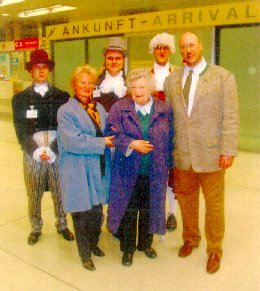
Frau Brigitte Draeseke, great grandniece of Felix Draeseke,
with
Karin and Carl Smith at her arrival in Graz, Austria,
for a
Ritter Viola Concert
 |
| |

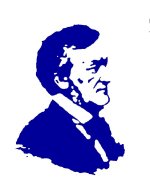
Welcome to The Wagner Society of Dallas. You know, as Texans, we're
bound to strive for being the biggest and best of all the Wagner groups
in the world over.
My hope, in addition, is that we ensure your attendance and
participation by offering an interesting, stimulating, and enjoyable
array of meetings, recitals, and travel. Let us know if you have
suggestions for future activities, and do make an effort to join in
during the coming months with your membership, attendance, and above all
joy of being with fellow Wagner aficionados.
Roger Carroll
President of the Wagner Society of Dallas
The Wagner Society of Dallas - Virginia R.
Abdo and Dr. James T. Wheeler,
Co-Founders
The Wagner Society of Dallas is devoted to furthering the enjoyment
and appreciation of the music of Richard Wagner. The Dallas group is one
of many Wagner Societies all over the world. It is a non-profit
organization open to anyone who enjoys the works of Richard Wagner and
who would like to participate in the Society’s activities.
The Wagner Society of Dallas has monthly meetings and programs which
feature recitals, lectures, video screenings, receptions for opera
singers and personalities, and trips to Wagner performances in other
cities. We welcome music lovers who are already familiar with Wagner’s
works as well as those who may want to become more knowledgeable about
Wagner’s music.
Member Benefits include attendance at programs, our newsletter,
discount on books and CD’s, advance notice of events and selected ticket
services, receipt of the Membership Directory, ticket allotments to
Bayreuth, and an active link with fellow Wagnerians throughout the
world. |
|

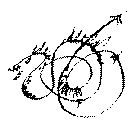


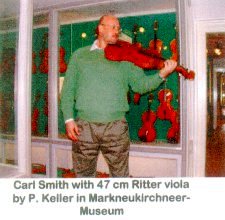


















 The term, "Ritter viola", refers to the violist and music
author Hermann Ritter. Ritter was born on September 16, 1849 in
Wismar, Germany, and died on January 25, 1926. In 1865, Ritter
began violin studies at the "Neuen Akademie der Tonkunst" (New
Academy of Tonal Art) in Berlin. He studied there until 1870,
giving lessons to finance his education. He studied there for a
short time with Joseph Joachim. In 1870, he became a member of
the Court Ensemble in Schwerin for two years, followed by the
position as conductor of the Heidelberg City Orchestra. He
retired shortly from this position to study music and art
history and philosophy in Heidelberg University. During these
studies, he turned to the viola, with the aim to equal its tone
to that of the violin and cello. In his study of the development
of stringed instruments, he stumbled across the manuscript
"Geometric Principles of Violin Making" by Antonio Bagatella,
printed 1782 in Padua, Italy. According to these principles, he
commissioned the Wurtzburg violinmaker, Karl Adam Hoerlein
(1824-1902), to build him a "Viola alta", as he termed it. Most
likely from a recommendation of Professor Ludwig Nohi, with whom
Ritter had studied music history, he was invited to Bayreuth.
The term, "Ritter viola", refers to the violist and music
author Hermann Ritter. Ritter was born on September 16, 1849 in
Wismar, Germany, and died on January 25, 1926. In 1865, Ritter
began violin studies at the "Neuen Akademie der Tonkunst" (New
Academy of Tonal Art) in Berlin. He studied there until 1870,
giving lessons to finance his education. He studied there for a
short time with Joseph Joachim. In 1870, he became a member of
the Court Ensemble in Schwerin for two years, followed by the
position as conductor of the Heidelberg City Orchestra. He
retired shortly from this position to study music and art
history and philosophy in Heidelberg University. During these
studies, he turned to the viola, with the aim to equal its tone
to that of the violin and cello. In his study of the development
of stringed instruments, he stumbled across the manuscript
"Geometric Principles of Violin Making" by Antonio Bagatella,
printed 1782 in Padua, Italy. According to these principles, he
commissioned the Wurtzburg violinmaker, Karl Adam Hoerlein
(1824-1902), to build him a "Viola alta", as he termed it. Most
likely from a recommendation of Professor Ludwig Nohi, with whom
Ritter had studied music history, he was invited to Bayreuth.




